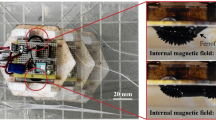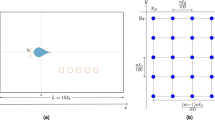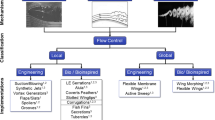Abstract
A control methodology for aerial or aquatic vehicles is presented that leverages intelligent distributed sensing inspired by the lateral line found in fish to directly measure the fluid forces acting on the vehicle. As a result, the complex robot control problem is effectively simplified to that of a rigid body in a vacuum. Furthermore, by sensing these forces, they can be compensated for immediately, rather than after they have displaced the vehicle. We have created a sensory shell around a prototype autonomous underwater vehicle, derived algorithms to remove static pressure and calculate total force from the discrete measurements using a fitting technique that filters sensor error, and validated the control methodology on a vehicle in the presence of multiple fluid disturbances. This sensing control scheme reduces position tracking errors by as much as 72% compared to a standard position error feedback controller.
This is a preview of subscription content, access via your institution
Access options
Access Nature and 54 other Nature Portfolio journals
Get Nature+, our best-value online-access subscription
$29.99 / 30 days
cancel any time
Subscribe to this journal
Receive 12 digital issues and online access to articles
$119.00 per year
only $9.92 per issue
Buy this article
- Purchase on Springer Link
- Instant access to full article PDF
Prices may be subject to local taxes which are calculated during checkout





Similar content being viewed by others
Data availability
Any data gathered and reported in this study can be provided by the corresponding author upon request.
References
Bellingham, J. G. & Wilcox, J. S. Optimizing AUV oceanagraphic surveys. In Proc. IEEE/OES Symposium on Autonomous Underwater Vehicle Technology 391–398 (IEEE, 1996).
Whitcomb, L. L., Yoerger, D. R., Singh, H. & Mindell, D. A. Towards precision robotic maneuvering, survey, and manipulation in unstructured undersea environments. In Proc. International Symposium on Robotics Research 45–54 (Springer, 1998).
Yoerger, D. & Slotine, J. J. E. Adaptive sliding control of and experimental underwater vehicle. In Proc. IEEE International Conference on Robotics and Automation (ICRA) 2746–2751 (IEEE, 1991).
Martin, S. C. & Whitcomb, L. L. Fully actuated model-based control with six-degree-of-freedom coupled dynamical plant models for underwater vehicles: theory and experimental evaluation. Int. J. Robot. Res. 35, 1164–1184 (2016).
Liao, J. C. A review of fish swimming mechanics and behaviour in altered flows. Philos. Trans. R. Soc. B 362, 1973–1993 (2007).
Blaxter, J. H. S. Structure and development of the lateral line. Biol. Rev. 62, 471–514 (1987).
Pitcher, T. J., Partridge, B. L. & Wardle, C. S. A blind fish can school. Science 194, 963–965 (1976).
Coombs, S. Smart skins: information processing by lateral line sensors. Auton. Robots 11, 225–261 (2001).
Bleckmann, H. Peripheral and central processing of lateral line information. J. Comp. Physiol. A 194, 145–158 (2008).
Montgomery, J. C. & Macdonald, J. A. Sensory tuning of lateral line receptors in Antarctic fish to the movement of planktonic prey. Science 235, 195–196 (1987).
Pohlmann, K., Atema, J. & Breithaupt, T. The importance of the lateral line in nocturnal predation of piscivorous catfish. J. Exp. Biol. 207, 2971–2978 (2004).
Satou, M. et al. Behavioral and electrophysiological evidences that the lateral line is involved in the inter-sexual vibrational communication of the himé salmon (landlocked red salmon, Oncorhynchus nerka). J. Comp. Physiol. A 174, 539–549 (1994).
Kroese, A. B. A., Van der Zalm, J. M., Van & den Bercken, J. Frequency response of the lateral-line organ of Xenopus laevis. Pflügers Arch. 375, 167–175 (1978).
Coombs, S. & Montgomery, J. Function and evolution of superficial neuromasts in an Antarctic notothenioid fish. Brain Behav. Evol. 44, 287–298 (1994).
Munz, H. in The Mechanosensory Lateral Line 285–297 (Springer, 1989).
Fan, Z. et al. Design and fabrication of artificial lateral line flow sensors. J. Micromech. Microeng. 12, 655–661 (2002).
Kottapalli, A. G. P. et al. A liquid crystal polymer membrane MEMS sensor for flow rate and flow direction sensing applications. J. Micromech. Microeng. 21, 085006 (2011).
Dagamseh, A., Wiegerink, R., Lammerink, T. & Krijnen, G. Imaging dipole flow sources using an artificial lateral-line system made of biomimetic hair flow sensors. J. R. Soc. Interface 10, 20130162 (2013).
Abdulsadda, A. T. & Tan, X. Underwater tracking of a moving dipole source using an artificial lateral line: algorithm and experimental validation with ionic polymer–metal composite flow sensors. Smart Mater. Struct. 22, 045010 (2013).
Fernandez, V. I. et al. Lateral-line-inspired sensor arrays for navigation and object identification. Mar. Technol. Soc. J. 45, 130–146 (2011).
Chambers, L. et al. A fish perspective: detecting flow features while moving using an artificial lateral line in steady and unsteady flow. J. R. Soc. Interface 11, 20140467 (2014).
Ren, Z. & Mohseni, K. A model of the lateral line of fish for vortex sensing. Bioinspir. Biomim. 7, 036016 (2012).
Ren, Z. & Mohseni, K. Wall detection by lateral line sensory system of fish. In Proc. AIAA Aerospace Sciences Meeting 2014-0072 (AIAA, 2014).
Xu, Y. & Mohseni, K. A pressure sensory system inspired by the fish lateral line: hydrodynamic force estimation and wall detection. IEEE J. Ocean. Eng. 42, 532–543 (2016).
Xu, Y. & Mohseni, K. Bio-inspired hydrodynamic force feed forward for autonomous underwater vehicle control. IEEE ASME Trans. Mechatron. 19, 1127–1137 (2014).
Akanyeti, O. et al. Self-motion effects on hydrodynamic pressure sensing: part I. Forward–backward motion. Bioinspir. Biomim. 8, 026001 (2013).
Kottapalli, A. G. P., Asadnia, M., Miao, J. M., Barbastathis, G. & Triantafyllou, M. S. A flexible liquid crystal polymer MEMS pressure sensor array for fish-like underwater sensing. Smart Mater. Struct. 21, 115030 (2012).
Paley, D. A. & Free, B. A. Model-based observer and feedback control design for a rigid Joukowski foil in a Karman vortex street. Bioinspir. Biomim. 13, 035001 (2018).
Arnold, G. P. Rheotrophism in fishes. Biol. Rev. 49, 515–576 (1974).
Montgomery, J. C., Baker, C. F. & Carton, A. G. The lateral line can mediate rheotaxis in fish. Nature 389, 960–963 (1997).
Nelson, K. & Mohseni, K. Design of a 3-D printed, modular lateral line sensory system for hydrodynamic force estimation. Mar. Technol. Soc. J. 51, 103–115 (2017).
Song, Z., Lipinski, D. & Mohseni, K. Multi-vehicle cooperation and nearly fuel-optimal flock guidance in strong background flows. Ocean Eng. 141, 388–404 (2017).
Song, Z. & Mohseni, K. Long-term inertial navigation aided by dynamics of flow field features. IEEE J. Ocean. Eng. 43, 940–954 (2017).
Fossen, T. I. Guidance and Control of Ocean Vehicles (Wiley, 1994).
Paull, L., Saeedi, S., Seto, M. & Li, H. Auv navigation and localization: a review. IEEE J. Ocean. Eng. 39, 131–149 (2014).
Ruiz, I. T., de Raucourt, S., Petillot, Y. & Lane, D. Concurrent mapping and localization using sidescan sonar. IEEE J. Ocean. Eng. 29, 442–456 (2004).
Eustice, R. M., Singh, H., Leonard, J. J. & Walter, M. R. Visually mapping the RMS titanic: conservative covariance estimates for SLAM information filters. Int. J. Robot. Res. 25, 1223–1242 (2006).
Krieg, M. & Mohseni, K. Dynamic modeling and control of biologically inspired vortex ring thrusters for underwater robot locomotion. IEEE Trans. Robot. 26, 542–554 (2010).
Antonelli, G., Caccavale, F., Chiaverini, S. & Villani, L. Tracking control for underwater vehicle-manipulator systems with velocity estimation. IEEE J. Ocean. Eng. 25, 399–413 (2000).
Yoerger, D. & Slotine, J. Robust trajectory control of underwater vehicles. IEEE J. Ocean. Eng. 10, 462–470 (1985).
Healey, A. J. & Lienard, D. Multivariable sliding mode control for autonomous diving and steering of unmanned underwater vehicles. IEEE J. Ocean. Eng. 18, 327–339 (1993).
Yuh, J. Modeling and control of underwater robotic vehicles. IEEE Trans. Syst. Man Cybern. 20, 1475–1483 (1990).
Marco, D. B. & Healey, A. J. Local area navigation using sonar feature extraction and model-based predictive control. Int. J. Syst. Sci. 29, 1123–1133 (1998).
Kim, T. W. & Yuh, J. A novel neuro-fuzzy controller for autonomous underwater vehicles. In Proc. International Conference on Robotics and Automation 2350–2355 (IEEE, 2001).
Walters, P., Kamalapurkar, R., Voight, F., Schwartz, E. M. & Dixon, W. E. Online approximate optimal station keeping of a marine craft in the presence of an irrotational current. IEEE Trans. Robot. 34, 486–496 (2018).
Krieg, M., Klein, P., Hodgkinson, R. & Mohseni, K. A hybrid class underwater vehicle: bioinspired propulsion, embedded system, and acoustic communication and localization system. Mar. Technol. Soc. J. Spec. Ed. Biomim. Mar. Technol. 45, 153–164 (2011).
Krieg, M., Nelson, K., Eisele, J. & Mohseni, K. Bioinspired jet propulsion for disturbance rejection of marine robots. IEEE Robot. Autom. Lett. 3, 2378–2385 (2018).
Krieg, M. & Mohseni, K. Thrust characterization of pulsatile vortex ring generators for locomotion of underwater robots. IEEE J. Ocean. Eng. 33, 123–132 (2008).
Krieg, M. & Mohseni, K. Modelling circulation, impulse and kinetic energy of starting jets with non-zero radial velocity. J. Fluid Mech. 719, 488–526 (2013).
Krieg, M. & Mohseni, K. Pressure and work analysis of unsteady, deformable, axisymmetric, jet producing cavity bodies. J. Fluid Mech. 769, 337–368 (2015).
Acknowledgements
This work was supported by the Office of Naval Research (ONR) and the National Science Foundation (NSF).
Author information
Authors and Affiliations
Contributions
M.K. helped design the prototype AUV and derived the force-processing algorithms. K.N. was responsible for all stages of system testing and helped design and validate the custom modular distributed pressure sensory system. K.M. supervised and provided advice for the entire research project, and helped edit and write the paper.
Corresponding author
Ethics declarations
Competing interests
The authors declare no competing interests.
Additional information
Publisher’s note: Springer Nature remains neutral with regard to jurisdictional claims in published maps and institutional affiliations.
Supplementary information
Supplementary Information
Figures, Discussion, Methods, References
Supplementary Video
Experiment with AUV in water tank
Rights and permissions
About this article
Cite this article
Krieg, M., Nelson, K. & Mohseni, K. Distributed sensing for fluid disturbance compensation and motion control of intelligent robots. Nat Mach Intell 1, 216–224 (2019). https://doi.org/10.1038/s42256-019-0044-1
Received:
Accepted:
Published:
Issue Date:
DOI: https://doi.org/10.1038/s42256-019-0044-1
This article is cited by
-
High-stretch, tendon-driven, fiber-reinforced membrane soft actuators with multiple active degrees of freedom
Communications Engineering (2024)
-
Highly sensitive and broadband meta-mechanoreceptor via mechanical frequency-division multiplexing
Nature Communications (2023)
-
Machine learning for flow-informed aerodynamic control in turbulent wind conditions
Communications Engineering (2022)
-
Underwater wireless communication via TENG-generated Maxwell’s displacement current
Nature Communications (2022)



